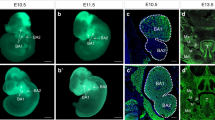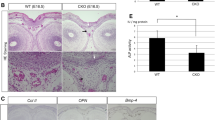Abstract
Extensive studies have pinpointed the crucial role of Indian hedgehog (Ihh) signaling in the development of the appendicular skeleton and the essential function of Ihh in the formation of the temporomandibular joint (TMJ). In this study, we have investigated the effect of augmented Ihh signaling in TMJ development. We took a transgenic gain-of-function approach by overexpressing Ihh in the cranial neural crest (CNC) cells using a conditional Ihh transgenic allele and the Wnt1-Cre allele. We found that Wnt1-Cre-mediated tissue-specific overexpression of Ihh in the CNC lineage caused severe craniofacial abnormalities, including cleft lip/palate, encephalocele, anophthalmos, micrognathia, and defective TMJ development. In the mutant TMJ, the glenoid fossa was completely absent, whereas the condyle and the articular disc appeared relatively normal with slightly delayed chondrocyte differentiation. Our findings thus demonstrate that augmented Ihh signaling is detrimental to craniofacial development, and that finely tuned Ihh signaling is critical for TMJ formation. Our results also provide additional evidence that the development of the condyle and articular disc is independent of the glenoid fossa.






Similar content being viewed by others
References
Beresford WA (1975) Schemes of zonation in the mandibular condyle. Am J Orthod 68:189–195
Chai Y, Jiang X, Ito Y, Bringas PJ, Han J, Rowitch DH, Soriano P, McMahon AP, Sucov HM (2000) Fate of the mammalian cranial neural crest during tooth and mandibular morphogenesis. Development 127:1671–1679
Chen J, Utreja A, Kalajzic Z, Sobue T, Rowe D, Wadhwa S (2012) Isolation and characterization of murine mandibular condylar cartilage cell populations. Cells Tissues Organs 195:232–243
Chiang C, Litingtung Y, Lee E, Young KE, Corden JL, Westphal H, Beachy PA (1996) Cyclopia and defective axial patterning in mice lacking Sonic hedgehog gene function. Nature 383:407–413
Chow RL, Lang RA (2001) Early eye development in vertebrates. Annu Rev Cell Dev Biol 17:255–296
Danielian PS, Muccino D, Rowitch DH, Michael SK, McMahon AP (1998) Modification of gene activity in mouse embryos in utero by a tamoxifen-inducible form of Cre recombinase. Curr Biol 8:1323–1326
Frommer J (1964) Prenatal development of the mandibular joint in mice. Anat Rec 150:449–461
Fukuoka H, Shibata S, Suda N, Yamashita Y, Komori T (2007) Bone morphogenetic protein rescues the lack of secondary cartilage in Runx2-deficient mice. J Anat 211:8–15
Gu S, Chen Y (2013) Temporomandibular joint development. In: Huang GT-J, Thesleff I (eds) Stem cells in craniofacial development and regeneration. Wiley-Blackwell, New York, pp 71–85
Gu S, Wei N, Yu L, Fei J, Chen Y (2008) Shox2-deficiency leads to dysplasia and ankylosis of the temporomandibular joint in mice. Mech Dev 125:729–742
Gu S, Wu W, Liu C, Yang L, Sun C, Ye W, Li X, Chen J, Long F, Chen Y (2014) BMPRIA mediated signaling is essential for temporomandibular joint development in mice. PLoS One 9:e101000
He F, Xiong W, Wang Y, Matsui M, Yu X, Chai Y, Klingensmith J, Chen Y (2010) Modulation of BMP signaling by Noggin is required for the maintenance of palatal epithelial integrity during palatogenesis. Dev Biol 347:109–121
Ingham PW, McMahon AP (2001) Hedgehog signaling in animal development: paradigms and principles. Genes Dev 15:3059–3087
Jiang X, Iseki S, Maxson RE, Sucov HM, Morriss-Kay GM (2002) Tissue origins and interactions in the mammalian skull vault. Dev Biol 241:106–116
Kantomaa T, Tuominen M, Pirttiniemi P (1994) Effect of mechanical forces on chondrocyte maturation and differentiation in the mandibular condyle of the rat. J Dent Res 73:1150–1156
Lanske B, Karaplis AC, Lee K, Luz A, Vortkamp A, Pirro A, Karperien M, Defize LH, Ho C, Mulligan RC, Abou-Samra AB, Jüppner H, Segre GV, Kronenberg HM (1996) PTH/PTHrP receptor in early development and Indian hedgehog-regulated bone growth. Science 273:663–666
Li X, Liu H, Gu S, Liu C, Sun C, Zheng Y, Chen Y (2014) Replacing Shox2 with human SHOX leads to congenital disc degeneration of the temporomandibular joint in mice. Cell Tissue Res 355:345–354
Luder HU, Leblond CP, Mark K von der (1988) Cellular stages in cartilage formation as revealed by morphometry, radioautography and type II collagen immunostaining of the mandibular condyle from weanling rats. Am J Anat 182:197–214
Mori-Akiyama Y, Akiyama H, Rowitch DH, Crombrugghe B de (2003) Sox9 is required for determination of the chondrogenic cell lineage in the cranial neural crest. Proc Natl Acad Sci U S A 100:9360–9365
Ochiai T, Shibukawa Y, Nagayama M, Mundy C, Yasuda T, Okabe T, Shimono K, Kanyama M, Hasegawa H, Maeda Y, Lanske B, Pacifici M, Koyama E (2010) Indian hedgehog roles in post-natal TMJ development and organization. J Dent Res 89:349–354
Oka K, Oka S, Sasaki T, Ito Y, Bringas PJ, Nonaka K, Chai Y (2007) The role of TGF-beta signaling in regulating chondrogenesis and osteogenesis during mandibular development. Dev Biol 303:391–404
Osumi-Yamashita N, Ninomiya Y, Doi H, Eto K (1994) The contribution of both forebrain and midbrain crest cells to the mesenchyme in the frontonasal mass of mouse embryos. Dev Biol 164:409–419
Presnell J, Schreibman M (1997) Humason’s animal tissue techniques, 5th edn. The Johns Hopkins University Press, Baltimore
Purcell P, Joo BW, Hu JK, Tran PV, Calicchio ML, O’Connell DJ, Maas RL, Tabin CJ (2009) Temporomandibular joint formation requires two distinct hedgehog-dependent steps. Proc Natl Acad Sci U S A 106:18297–18302
Purcell P, Jheon A, Vivero MP, Rahimi H, Joo A, Klein OD (2012) Spry1 and spry2 are essential for development of the temporomandibular joint. J Dent Res 91:387–393
Rice DP (2008) Developmental anatomy of craniofacial sutures. Front Oral Biol 12:1–21
Shibata S, Yokohama-Tamaki T (2008) An in situ hybridization study of Runx2, Osterix, and Sox9 in the anlagen of mouse mandibular condylar cartilage in the early stages of embryogenesis. J Anat 213:274–283
Shibata S, Suda N, Yoda S, Fukuoka H, Ohyama K, Yamashita Y, Komori T (2004) Runx2-deficient mice lack mandibular condylar cartilage and have deformed Meckel’s cartilage. Anat Embryol (Berl) 208:273–280
Shibukawa Y, Young B, Wu C, Yamada S, Long F, Pacifici M, Koyama E (2007) Temporomandibular joint formation and condyle growth require Indian hedgehog signaling. Dev Dyn 236:426–434
Silbermann M, Frommer J (1972) The nature of endochondral ossification in the mandibular condyle of the mouse. Anat Rec 172:659–667
Soriano P (1999) Generalized lacZ expression with the ROSA26 Cre reporter strain. Nat Genet 21:70–71
Sperber G (2001) Craniofacial development. Decker, Hamilton
St Amand T, Zhang Y, Semina EV, Zhao X, Hu Y, Nguyen L, Murray JC, Chen Y (2000) Antagonistic signals between BMP4 and FGF8 define the expression of Pitx1 and Pitx2 in mouse tooth-forming anlage. Dev Biol 217:323–332
St-Jacques B, Hammerschmidt M, McMahon AP (1999) Indian hedgehog signaling regulates proliferation and differentiation of chondrocytes and is essential for bone formation. Genes Dev 13:2072–2086
Trainor PA, Tam PP (1995) Cranial paraxial mesoderm and neural crest cells of the mouse embryo: co-distribution in the craniofacial mesenchyme but distinct segregation in branchial arches. Development 121:2569–2582
Vortkamp A, Lee K, Lanske B, Segre GV, Kronenberg HM, Tabin CJ (1996) Regulation of rate of cartilage differentiation by Indian hedgehog and PTH-related protein. Science 273:613–622
Wang Y, Liu C, Rohr J, Liu H, He F, Yu J, Sun C, Li L, Gu S, Chen Y (2011) Tissue interaction is required for glenoid fossa development during temporomandibular joint formation. Dev Dyn 240:2466–2473
Xiong W, He F, Morikawa Y, Yu X, Zhang Z, Lan Y, Jiang R, Cserjesi P, Chen Y (2009) Hand2 is required in the epithelium for palatogenesis in mice. Dev Biol 330:131–141
Yasuda T, Mundy C, Kinumatsu T, Shibukawa Y, Shibutani T, Grobe K, Minugh-Purvis N, Pacifici M, Koyama E (2010) Sulfotransferase Ndst1 is needed for mandibular and TMJ development. J Dent Res 89:1111–1116
Zhang Z, Yu X, Zhang Y, Geronimo B, Lovlie A, Fromm SH, Chen Y (2000) Targeted misexpression of constitutively active BMP receptor-IB causes bifurcation, duplication, and posterior transformation of digit in mouse limb. Dev Biol 220:154–167
Author information
Authors and Affiliations
Corresponding authors
Ethics declarations
Disclosure statement
The authors declare no conflicts of interests pertaining to this article.
Additional information
This work was supported by the NIHR01 DE17792 (to Y.C.). L.Y. was supported by a fellowship from the China Scholarship Council (no. 201208440191).
Rights and permissions
About this article
Cite this article
Yang, L., Gu, S., Ye, W. et al. Augmented Indian hedgehog signaling in cranial neural crest cells leads to craniofacial abnormalities and dysplastic temporomandibular joint in mice. Cell Tissue Res 364, 105–115 (2016). https://doi.org/10.1007/s00441-015-2306-5
Received:
Accepted:
Published:
Issue Date:
DOI: https://doi.org/10.1007/s00441-015-2306-5




